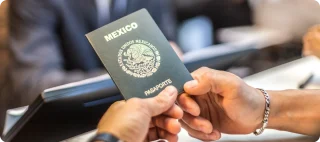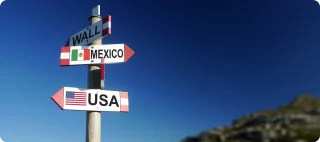
Visa to Mexico, Entry, and Customs
Entry & Customs
As of March 1st, 2010 the Mexican government requires that all American and Canadian citizens who want to visit Mexico show a valid passport.
What are the Mexico entry requirements?
How do I obtain a Visitor’s Permit FMM?
How do I obtain a vehicle importation permit?
When is the best time to cross the U.S. ‑ Mexico border?
WARNING!
It is illegal in Mexico, to carry in your vehicle or personal belonging any of the following items:
- Fire arms, bullets, explosives and related chemical substances
- Recreational drugs, narcotics, psychotropic and other illegal substances
Be aware that the preparation, sale, purchase, supply, transportation, introduction or removal from the country of any of the above items is a crime punishable by 10 to 25 years in prison.
Mexico Entry Requirements (back to list)
The Government of Mexico requires that all U.S. and Canadian citizens to present a passport or a passport card to enter the country.
Do I need a Visa? (back to list)
U.S. and Canadian citizens are not required to obtain a formal visa. You will need to obtain an FMM (Forma Migratoria Multiple) or Visitor’s Permit.
A visitor’s permit is for tourist stays of 7 days or less within “the border zone,” defined as an area of 20 to 30 kilometers of the border with the U.S., depending on the location. U.S. citizens traveling as tourists beyond the border zone must pay a fee to obtain the FMM or Visitor’s permit. Entering under a Visitor’s Permit, you are not allowed to engage in any paid activity in Mexico.
If your declared destination is Central America and you are transporting vehicles or goods, known as “transmigrante”, you will need to obtain a Visa at a Mexican Consulate and use a Customs Broker to get your merchandise through Mexico.

How do I obtain a Visitor’s Permit FMM? (back to list)
If you are crossing the border and entering thru the Northern states of Mexico, you are now able to complete the Visitor’s permit (FMM) online.
You will be able to make the payment online as well and have the form filled out and ready to make the process at the border a lot easier. Once paid, you will be able to print a receipt for payment, and the FMM form. You have 30 days after submitting the payment to use the card. All you need to do is to stop at the Mexican immigration office at the border and the agent will stamp your FMM form, making it official. Without the stamp, the form is not considered an official document. Completing the Visitor’s permit online, will facilitate your entry to Mexico and save you time at the border. Fill out the form online here.
If you are not able to complete the form online, FMM forms or Tourist cards are available at immigration offices/booths at the border, at airports, or other points of entry.
If you are a citizen of a country other than the U.S. and Canada, check with a Mexican consulate for regulations, which apply, to you.
To obtain visitor’s permit immigration form (FMM), you must present a Passport for each individual traveling into the interior of Mexico. The fee is approx. $30.00 USD* (per person) which must be paid in pesos at a Mexican Bank.
For short‑term Business travelers, you will also use the new FMM Visitor’s form authorizing the conduct of business, but not employment. Travelers entering Mexico for purposes other than tourism or business or for stays longer than 180 days require a Temporary Resident Visa and must carry a valid U.S. passport anywhere within the country, including the border zone. US citizens planning to work or live in Mexico should apply for the appropriate Mexican visa at the Mexican consulate nearest you in the United States.
The government of Mexico strictly regulates the entry of vehicles into Mexico.
It is important for visitors to remember the following steps when crossing the border between the United States and Mexico by automobile. There are no procedures to comply with if you are traveling within the Border Zone or Free Trade Zone (including the Baja California Peninsula and the Sonora Free Trade Zone). If you wish to travel past these zones, you will need to adhere to certain procedures. It is important to note that in the case of Baja California even though you can take your vehicle all the way to the end of the peninsula without a vehicle permit (see vehicle importation regulations), you must have a Visitor’s permit (FMM) if you plan to go south of San Quintin.
Tourists wishing to travel beyond the border zone with their car must obtain a temporary import permit.

How do I obtain a Vehicle Importation Permit? (back to list)
- To acquire a permit, the owner’s original Vehicle Title or Registration Receipt is needed.
- If the vehicle is financed, a rental car, leased, and/or a company car, a notarized letter of permission is required from the lien holder or lending institution.
- Valid Driver’s License (with photo and same name of title).
- The fee for the importation of a vehicle is $45.00 USD plus IVA; this fee is the same when the permit is obtained at the border, consulates or online. https://www.banjercito.com.mx/registroVehiculos/.
-
A guarantee deposit for the return of the vehicle to the US, regardless of the form payment, will be applied to all vehicles. The amount of the guarantee will be determined by the year of the vehicle.
The guarantee will be refunded upon cancellation of the permit at Banjercito offices, as long it is prior to the expiration date of the permit.The refund will be made in the same form as the deposit was made.
- If the vehicle is not returned to the US prior to the expiration date of the permit or the permit is not canceled upon exiting Mexico, the guarantee deposit will be forfeited.
-
Before Banjercito issues a permit, they will verify the VIN # to make sure the vehicle does not have any restrictions to be driven in the US or Canada, in which case the permit will not be allowed.
It is important that we remind you that the permit is canceled at the border prior to returning to the US to ensure that guarantee deposit is returned to the importer. Keep your receipt!.
- The permit is valid for up to six months. The vehicle may be driven across the border multiple times during the authorized period of the permit. You MUST return the vehicle back to the United States before the 6 months expiration, or your guarantee deposit would be forfeited. A receipt will be issued when the permit is canceled and the deposit will be returned in the same format that it was paid. Failure to turn in your vehicle’s permit before the expiration date may result in denial of entry into Mexico on your next trip, Mexico is very strict about this rule.
What can I take into Mexico? (back to list)
When crossing into Mexico, if you have no merchandise to declare, you must go through the Stop and Go light checkpoint. A green light means proceed ahead without inspection. A red light means stop for inspection.
When you travel to Mexico by airplane or by ship, you are allowed to import (duty‑free) a total of items worth up to $300 per person (including children). For example, a family of five members consisting of the parents and three minor children can import up to $1,500 worth of merchandise, duty‑free. During periods where the Programa Paisano is in effect (Holy Week, Summer and Winter) Mexican Nationals living abroad, crossing the border by land, will be able to take items worth up to $500 per person.
When you bring items whose value exceeds the above‑mentioned limits, but not more than $1,000.00, you can pay the taxes yourself. If your merchandise is worth more than $1,000.00, you must use the services of a customs broker.
If the flight by which you arrive come from the border zone you are allowed only $50.00 of new items per person.
If you are a resident in Mexico you are allowed to bring in free of duty the following items for your personal use: Two cameras or video camera if it can be carried by the passenger; photographic materials; three cell phones, one GPS, one laptop, one small printer, one external memory and its accessories. Two personal articles of sports equipment or a used set of equipment that can be hand carried; books and magazines; 20 packages of cigarettes or 25 cigars or 200 grains of tobacco; 3 liters of wine, beer or liquor (adults only); medicines for personal use or with a Doctor’s prescription, if it is a controlled substance; and the suitcases to carry baggage.

Tourist are allowed to bring in their personal effects duty‑free, in addition to the above, your personal effects may include: New or used well for personal use, such as clothing, footwear, and hygiene products, so long as they are in accordance with the duration of the trip, and their quantity does not suggest that they can be the object of commercialization. A tourist can also bring a set of binoculars, a photographic camera and a video recorder (their power sources too), a television, a radio or radio‑cassette, tape, CD, or DVD player, a personal computer (i.e. laptop, notebook, Omni book, etc.), up to 30 recording tapes or CD’s, 5 DVD’s, 12 rolls of unused film, a cell phone, a typewriter, a musical instrument that can be hand carried, books & magazines (whose quantity does not suggest that they can be the object of commercialization). For outdoor activities tourist can bring a camping tent and camping equipment, a set of fishing equipment, a pair of skis, 5 used toys for minors (as long as they can be transported by one person), two sets of used personal sports equipment (as long as they can be transported by one person), a motor‑less boat less than 5 1/2 meters long or surfboard with or without a sail. Regarding disabled persons, goods for personal use that, by their characteristics, compensate for or diminish their disability. Tourist can bring medicine for personal use (The prescription must be shown if they are psychotropic substances). Adult passengers may also bring a maximum of 20 packs of cigarettes, 25 cigars or 200 grams of tobacco, and up to 3 liters of wine, beer, or liquor, with the understanding that a larger quantity of these products cannot be imported without complying with the applicable regulations and restrictions.
If you are inspected and are discovered with items of greater value than is permitted and you have not paid duty on them, you risk having to pay a high fine (of up to four times the value of each item) or seizure of the goods as a contraband plus the seizure of the car in which the goods are traveling. If weapons or ammunition are found, the penalty could include imprisonment.
The following are products you can take into Mexico without previous authorization:
- dehydrated or canned foods
- roasted coffee (packaged),
- fresh or dry meats (beef, sheep or goat from the US or Canada) candy (not lactic)
- bamboo (dry)
- dried spices
- dry herbal medicines
- dry or preserved insects canned jellies or fruit preserves nuts
- straw articles or artisans dried fish
- cheese (processed in the US or Canada) canned or processed sauces soups without meat canned or processed vegetables
- dogs or cats (with health certificate).
Penalties for drug offenses are strict and convicted offenders can expect large fines and jail sentences up to 25 years.
When to Cross (back to list)
Clearing Customs may vary from 30 minutes to several hours. The best time is on weekdays, early in the morning. Weekends are the worst time, especially holidays. If you got a late start, expect a long wait. If you arrive at the border in the afternoon, it may be more convenient to get your papers in the evening of the day before departure so as to get an early morning start the next day.
